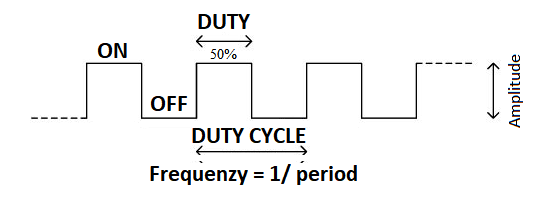[vc_row][vc_column][vc_column_text]PWM dimming, or Pulse Width Modulation, is a digital dimming technology that uses a series of pulses to adjust the brightness of LED lights. The technology works by rapidly switching the power of LED lights on and off at a high frequency that the human eye cannot detect. The duty cycle is used to control the brightness of the lights. This is a supplement to the lighting dimming technology article series.
How does PWM dimming work?
One of the main advantages of PWM dimming is its accuracy. Unlike analogue dimming methods, PWM dimming can achieve a wide range of brightness levels with high accuracy.
This method is used in many sectors. It is used in applications such as measurement, communications, power control and LED lighting. By switching analogue devices to precise digital control, the amount of energy used by a system can be significantly reduced by adjusting, for example, the amount of light, sound output or rotation speed.
Dimming is achieved in practice at the 0-100% level with 0.1% accuracy, by adjusting the time the light is on.
PWM dimming for dummies for like me
Imagine you have a light bulb and you want to adjust its brightness. Instead of just switching it on and off, you can use a special tool called PWM dimming.
It works by rapidly switching the light on and off several times per second. Each time the light turns on and off, it is called a “pulse”. The faster you blink the light, the brighter the room will be because the light is on for more time. Similarly, if you flick the light on and off slowly, you get the feeling that the room has little light in it. So if the light is on for a long time, it is brighter. If it’s on for a short time, it’s dimmer.
What is the Duty Cycle?
Duty Cycle is the percentage of time the PWM signal is up (on) compared to the time it is down (off) during a single PWM cycle. It is expressed as a percentage and determines the average value of the PWM signal and the amount of power applied to the load. A 50% duty cycle means that the PWM signal is on for half of the cycle and off for the other half. That is, 100% of the duty cycle is lights on all the time.

Hertz
The hearts in this case are light on and off in revolutions per second. If the light is flicked on and off 100 times per second it is 100Hz. Here comes the other side of PWM dimming. To the eye, there is no advantage to having the light off 50% of the time, but one duty cycle lasts one second. It just looks to the eye that it was turned off.
Light flicker in PWM dimming
Flickering in some LED lights. This is because a fast power-up can cause the LED lights to flash at the same frequency as the pulses.
In PWM dimming, this on and off cycling must therefore occur quickly enough to be perceived by the eye as a dimming of the light and not as a flickering.

The light has to turn on and off 18 times a second for our brain to perceive that it is still on, yet the light still flashes in our eyes. It is about Flicker Fusion Time It has been studied and found that in animals or humans that limit can be as high as 400Hz! In general, the light has to go on and off at least 80 times a second to avoid flashing for most of us. That’s why some of us can see the light flashing and some of us can’t. So it is individual.
However, this problem can be mitigated by using a high-frequency PWM dimming signal. LedStore’s dimmable transformers use FFT 750Hz – 1000Hz, i.e. Flicker free.
Compatibility
The advantage of PWM dimming is its compatibility with a wide range of LED lights. Unlike other digital dimming technologies such as DALI or DMX, PWM dimming can be used with most types of LED lights without the need for special drivers or controllers. This makes it a cost-effective and widely available dimming option.
A weakness of the PWM dimming signal may be that it can cause colour changes in some LED lights. This is because rapid power changes can cause changes in the colour temperature of the lights. However, this problem can be mitigated by using a good quality PWM dimmer
PWM dimmer
A PWM dimmer is required to use PWM dimming. These controllers can be stand-alone devices or integrated with other systems, such as lighting control systems. It is important to use a high quality PWM dimming controller designed for use with LED lights to ensure compatibility and minimise potential problems.
Often a PWM dimmer can be found at the base of a table lamp

Good and bad points of PWM dimming
Plus:
- High compatibility: the PWM dimmer is compatible with a wide range of LED lights, making it a versatile option for dimming different types of lights.
- Smooth dimming: PWM dimming provides smooth and flicker-free dimming, making it ideal for use in environments where lighting needs to be adjusted frequently or where flicker can cause eye strain or headaches.
- Energy efficiency: PWM dimming can help reduce energy consumption by allowing precise control of the amount of power supplied to the luminaires.
- Longer life: PWM dimming can help extend the life of LED lights by reducing the amount of heat generated during dimming, which can damage lights over time.
Cons:
- Complexity: this can make the system more complex and difficult to install or troubleshoot.
- Interference: PWM dimming can cause electromagnetic interference (EMI), which can cause problems with other electronic equipment if not properly protected.
Overall, PWM dimming is a reliable and efficient method for dimming LED lights, with the added benefit of smooth, accurate and flicker-free dimming. However, it has some drawbacks related to its complexity, possible electromagnetic interference. However, it is important to use a high frequency PWM dimming signal and a good quality PWM dimming controller to minimise potential problems.[/vc_column_text][/vc_column][/vc_row][vc_row][vc_column][vc_column_text]
Frequently asked questions about pulse width modulation (PWM) dimming:
[/vc_column_text][vc_toggle title=”What is PWM dimming?”]PWM dimming is a method of controlling the brightness of LED lights by switching the power on and off rapidly at high frequency. This creates a dimming effect while maintaining energy efficiency.[/vc_toggle][vc_toggle title=”How does PWM dimming work?”]PWM dimming works by using a special controller that sends power pulses to the LEDs at a high frequency. How long the power is on or off determines the overall brightness of the lights.[/vc_toggle][vc_toggle title=”Is PWM dimming compatible with all LED lights?”]PWM dimming is generally compatible with a wide range of LED lights, but it is important to check the specifications of the lights to make sure they are compatible with PWM dimming.[/vc_toggle][vc_toggle title=”What are the advantages of PWM dimming?”]PWM dimming offers several advantages, such as smooth and flicker-free dimming, better energy efficiency and longer LED light life.[/vc_toggle][vc_toggle title=”What are the disadvantages of PWM dimming?”]PWM dimming requires the use of specialised controllers and drivers, which can make the system more complex and difficult to install or troubleshoot. It can also cause electromagnetic interference (EMI), which can cause problems with other electronic equipment if not properly protected.[/vc_toggle][vc_toggle title=”How can I ensure that my LED lights are compatible with PWM dimming?”]Most LED lights can be dimmed with PWM, but please contact the manufacturer to make sure they are compatible with PWM dimming.[/vc_toggle][vc_toggle title=”What types of PWM dimmer controllers are available?”]There are different types of PWM dimming controllers, such as potentiometer, digital or integrated in a lighting control system controller, such as the ZIgbee controller.[/vc_toggle][vc_toggle title=”How can I minimise interference from PWM dimming?”]Shielded cables and proper grounding can help minimize interference from PWM dimming.[/vc_toggle][vc_toggle title=”What are the common applications of PWM dimming?”]PWM dimming is commonly used in residential, commercial and industrial lighting applications.[/vc_toggle][vc_toggle title=”What should I consider when choosing a PWM dimmer controller?”]When choosing a PWM dimming controller, consider factors such as compatibility with LED lights, system complexity, potential interference and total system cost.[/vc_toggle][/vc_column][/vc_row][vc_row][vc_column][vc_column_text]
Led dimming specialist
LedStore has been an expert in LED lighting and lighting design since 2010. We have our own product design, so our products are technically state-of-the-art. Products have quarantee for up to 7 years. We also carry out lighting maintenance.
We focus on temperature-controlled and high colour rendering luminaires, so they work brilliantly and last a long time. We make around. 500 lighting designs for our clients’ sites. Read more here or order a design
We offer a service of custom-made LED strips, i.e. custom-made LED strips in aluminium profile. Also installed. Did you know? LedStore offers lighting design from 99 euros for the whole house!
Remember that we are always available to support you along the way, by email(myynti@ledstore.fi) and by phone (045 251 4510). As always, feel free to share photos of your own projects on social media at #ledstorefi IG and ledstore.fi FB. We love to see the cool things our LEDs do, and it helps to provide inspiration for those who are not sure about the power and awesomeness of LEDs. Did you know that we already have over 3500 pictures of our LED installations in our Gallery!
Photo gallery of Led lights:
Product gallery: pictures of products in different installation locations
Indirect light: indirect light in different spaces
Room-specific: Light in different rooms
References: complete houses that have been photographed[/vc_column_text][/vc_column][/vc_row]

